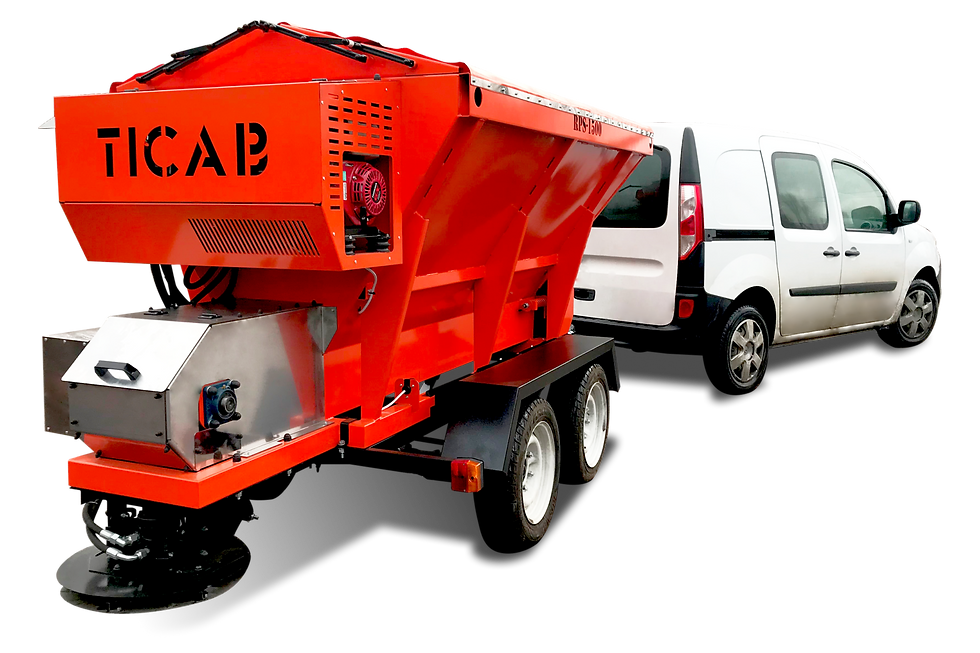Types of Sand and Salt Spreaders: Which One Fits Your Needs?
- TICAB Marketing
- Aug 4
- 3 min read

Winter road maintenance is critical for ensuring safety during icy and snowy conditions. Whether you're a municipality, a contractor, or a private facility manager, choosing the right sand and salt spreader can make all the difference in efficiency, cost, and performance. In this article, we’ll explore the main types of spreaders — mechanical, towed, and mounted — with a clear look at their pros and cons.
🔹 Mechanical vs. Hydraulic Spreaders: What’s the Difference?
When thinking about types of Sand and Salt Spreaders, the first decision to consider is how the spreader operates.
Mechanical Spreaders
These use mechanical linkages (often powered by the rotation of the wheels) to activate the spreading mechanism.
✅ Pros:
Simpler construction
Lower cost
Easy to maintain
Ideal for smaller operations
⛔ Cons:
Less precise spreading
No speed adjustment based on vehicle speed
Limited features for customization
Hydraulic Spreaders
These are powered by a vehicle's hydraulic system, allowing for greater control over speed, distribution rate, and pattern.
✅ Pros:
Highly accurate
Adjustable settings while operating
Handles heavier loads
Suitable for professional or municipal use
⛔ Cons:
More expensive
Requires hydraulic hookups
Slightly more complex to maintain
👉 Mechanical vs. hydraulic spreader? If you're looking for basic functionality, mechanical works well. But for demanding winter road maintenance, hydraulic spreaders offer precision and power.
🔹 Towed Sand and Salt Spreaders
Towed spreaders are attached to the rear of a vehicle (usually a pickup, tractor, or UTV) and operate either mechanically or with their own motor.
✅ Pros:
Easy to attach/detach
Great for covering large areas
Flexible use with different vehicles
Often more affordable than mounted spreaders
⛔ Cons:
Requires space to maneuver
May not be suitable for narrow roads or tight areas
Spreading control may be less advanced depending on the model
Ideal for:
Rural municipalities
Farms and private roads
Contractors with multiple vehicle types
🔹 Mounted Spreaders (Tailgate or Bed-Mounted)
Mounted spreaders are fixed to a vehicle — usually on the tailgate or within the truck bed — and powered by either hydraulics, gas engines, or electric motors.
Types:
Tailgate spreaders: Mounted on the back of a vehicle
V-box or hopper spreaders: Installed inside the truck bed
✅ Pros:
Professional-grade spreading
Compact and integrated design
Controlled directly from inside the cab
High capacity for large routes
⛔ Cons:
More expensive
Requires specific vehicle compatibility
Not as flexible as towed spreaders
Perfect for:
City and municipal use
Large commercial properties
High-demand contractors
🔹 Which Spreader Type Is Right for You?
Let’s break it down in a quick salt spreader comparison table:
Type | Best For | Key Benefit | Considerations |
Mechanical | Small businesses, light-duty tasks | Simple & low-cost | Less precision |
Hydraulic | Professional/municipal use | High control & power | Higher cost & complexity |
Towed Spreader | Farms, rural roads, flexible fleets | Versatile and budget-friendly | May lack advanced features |
Mounted Spreader | Cities, contractors, large properties | Integrated, high-performance | Requires dedicated vehicle |
🔹 Types of Sand and Salt Spreaders: Final Thoughts
Selecting the right sand and salt spreader depends on your operational needs, budget, and available vehicles. For small-scale or flexible use, towed spreaders are ideal. For precision and large-scale road treatment, mounted hydraulic spreaders are the gold standard.
Whatever your winter road maintenance goals, understanding the types of spreaders and their features will help you make the smartest investment — for safer roads and smoother operations.



Comments